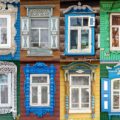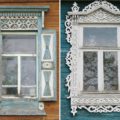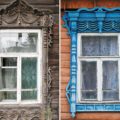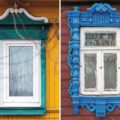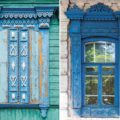Vividly decorated trims are typical for old wooden houses in Russia. Covered with elaborated patterns and brightly colored, these elements give a building an elegant look and highlight special cultural features of a particular area.
Strictly speaking, trims are not so much decorative but practical. There is always a small gap between the log frame wall and the window box. It is that very gap that should be closed by wooden plank of the trim. But Russian craftsmen could not just close the gap and do nothing more. The tradition of decorating wooden houses always flourished in Russia: craftsmen let elaborated pattern flow along the cornice, spared no effort to decorate the poles of the porch. Carved trims were almost a mandatory element of a window. How else could it be, if the facade is the face with which the house turns to the street, and therefore, in a sense, represents its owners to the world!
Most often trims were decorated with pierced work, when the board was drilled through with a saw or a jigsaw. This pattern resembles a wooden lace. But there is also “deaf thread”, when a pattern is carved on the board with a chisel and it looks like stucco. Sometimes trims were simply lacquered, but more often painted. One cannot say what is better: neat pure white pattern (exactly like an old lace collar!) or bright ornament of two or three different colors. Most trims preserved till the present day relate to the period from 1890 to 1960. There were two peaks in the popularity of carving: the turn of the XIX–XX centuries and ten years after the Second World War. Craftsmen engaged in carving were mostly local people. Some of them were more prolific and decorated hundreds of buildings during their creative careers, some only a few.
Masters in different parts of Russia stuck to some general plot, for example, they were inspired by architectural elements. The most characteristic example is Empire style lambrequin. Lambrequin is an element of ornament that imitates nicely hanging fabric. It turned out, that such lambrequins look well not only as a stucco of noble buildings, but also as a carved trims of wooden houses. There are examples of such decoration in Balashov town near Saratov, in Voshod village, Ryazan region, in Tomsk and in Vyazniki, Vladimir region. Volutes are another motif that carvers borrowed from the architects. In old districts of Irkutsk you can see rich merchants’ houses with large windows and steep curls of wooden volutes – rich Siberia did not want to give in to the capital. The carvers of the town of Kashin also made volutes, but they were smaller, simpler. And in Kirzhach, Vladimir region, a large artel of cutters worked, who came up with an unusual combination of Classical and Modern styles. Being colored these trims resemble Mikhail Vrubel’s paintings.
Trims blended seamlessly into the overall style of a building, their patterns went well together with carvings on facade and on shutters. One can find beautiful examples of integral design of shutters and trims in Novozybkov, Bryansk region, or in Siberian cities such as Omsk, Irkutsk, Krasnoyarsk.
Unfortunately, houses with trims become rare. When people replace worn out wooden window frames with plastic ones, they often simply burn these beautiful trims as stove wood.
Trims are unlucky: owners of houses do not value them, and they are completely not protected by the state. It’s enough to say that they are not considered to be folk craft products while spoon making is a folk craft. There are relevant courses in trade schools. Carved decoration of houses and trims were a sort of side business to many professionals: woodmen, carpenters together with the owners of houses themselves, so this occupation did not turn into an individual craft. But this still can be changed. There are thousands of houses with carved decoration and each of them is an exhibit of the world’s largest museum of wooden architecture named Russia.
What they need is attention. Here to paint, there to replace a small log, to curve a new element… Hurry up and see, cherish, and admire them. It is necessary to give at least small help to every master and every mistress of these houses. We should remember that they possess and keep not just a private house, but the face of the village, the face of the city and the face of our vast country.
Ivan Hafizov
The article uses the photographs of the author
 Ivan Hafizov is a professional photographer. Since 2007 he has been traveling around Russia and making photos of old houses with preserved trims. In 2010 Ivan shared the collection of his pictures in the Internet and launched a virtual museum on nalichniki.com. Since then, the virtual exhibition has been constantly growing, the most interesting photos are being printed in form of postcards, calendars and coloring books. In 2019 the book-album by Ivan Hafizov «Trims: Central Russia» was printed. Quality photos allow to clearly see the smallest details of the thread.
Ivan Hafizov is a professional photographer. Since 2007 he has been traveling around Russia and making photos of old houses with preserved trims. In 2010 Ivan shared the collection of his pictures in the Internet and launched a virtual museum on nalichniki.com. Since then, the virtual exhibition has been constantly growing, the most interesting photos are being printed in form of postcards, calendars and coloring books. In 2019 the book-album by Ivan Hafizov «Trims: Central Russia» was printed. Quality photos allow to clearly see the smallest details of the thread.

